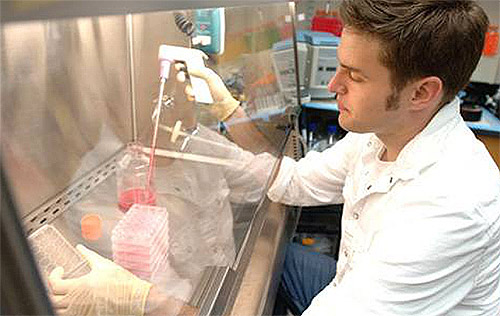Project Financing 2013
INDIETROFUNDING RESEARCH PROJECT "LAM" 2013

Acute Myeloid Leukemia ( AML ) accounts for 10-20% of leukemias that arise in childhood , with an incidence of approximately 65-70 new cases per year between the ages of 0 and 15 years. The LAM include a very heterogeneous group of disorders for clinical and genetic characteristics and , despite considerable progress in the therapeutic area in recent years, still have a particularly poor prognosis with a disease-free survival at 5 years after diagnosis by about 50 % .
Although the majority of pediatric AML present a genetic alteration known , about 20% show no cytogenetic or molecular marker and this subgroup is generally defined as a normal karyotype (CN- AML) . Through the deep sequencing of the transcriptome of 7 cases of CN- AML , the laboratory financed by the Foundation all'apporti Geneva Caltagirone has recently identified a novel fusion transcript involving the gene and the gene CBFA2T3 GLIS2 , both located on chromosome 16.
This genetic alteration is present in 10% of CN- AML and children carriers of this translocation showed a greater risk of recurrence and a 5-year survival significantly lower than children who do not have this anomaly. (3) Some recent studies in vitro support the hypothesis that the fusion gene CBFA2T3 - GLIS2 intervene in the process of leukemogenesis by aberrant activation of the Hedgehog signaling pathway that is implicated in the control of different cellular processes such as growth and differentiation . (1,2,4 ) Considering that there are drugs that selectively inhibit the Hedgehog pathway , the usefulness of these new targeted therapies in CN- AML expressing the fusion transcript CBFA2T3 - GLIS2 is an objective of primary interest to pursue.
The primary objectives of the research project are to clarify the link between the aberrant activation of the Hedgehog pathway , the presence of the fusion transcript CBFA2T3 - GLIS2 and the process of leukemogenesis ; experimentally determine whether selective inhibitors of the Hedgehog pathway may be used as a new targeted therapy in pediatric CN- LAM that show an aberrant activation of this signaling pathway , and finally identify , by Whole- transcriptome sequencing, additional new genetic alterations that can lead to aberrant activation of the Hedgehog pathway and which may benefit from a targeted therapy with selective inhibitors .
The results obtained from this study will clarify the genetic profile of the CN- AML pediatric allowing a better classification of patients into the correct classes of risk and address them to the most effective treatment protocols . The identification of the molecular alterations that lead to aberrant activation of the Hedgehog pathway may define a new class of CN- LAM in which specific inhibitors of this signaling pathway may be used as a new targeted therapy . In vitro and in vivo will allow to experimentally determine if the drugs currently on the market can be applied in this new clinical scenario , and considering that several of these inhibitors are already in use in different therapeutic protocols for other human cancers , there is the strong possibility that the results of this study have evidence of short-term clinical practice.

